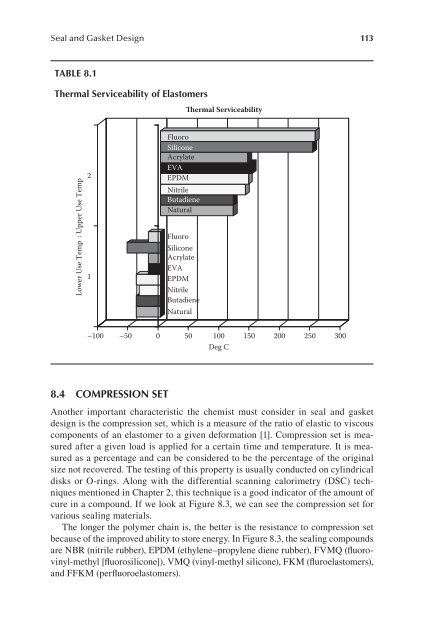THE ROLE OF THE
THE ROLE OF THE
THE ROLE OF THE
Create successful ePaper yourself
Turn your PDF publications into a flip-book with our unique Google optimized e-Paper software.
Seal and Gasket Design 113<br />
table 8.1<br />
thermal serviceability of elastomers<br />
Lower Use Temp : Upper Use Temp<br />
2<br />
1<br />
8.4 comPressIon set<br />
Fluoro<br />
Silicone<br />
Acrylate<br />
EVA<br />
EPDM<br />
Nitrile<br />
Butadiene<br />
Natural<br />
Fluoro<br />
Silicone<br />
Acrylate<br />
EVA<br />
EPDM<br />
Nitrile<br />
Butadiene<br />
Natural<br />
Thermal Serviceability<br />
–100 –50 0 50 100 150 200 250 300<br />
Deg C<br />
Another important characteristic the chemist must consider in seal and gasket<br />
design is the compression set, which is a measure of the ratio of elastic to viscous<br />
components of an elastomer to a given deformation [1]. Compression set is measured<br />
after a given load is applied for a certain time and temperature. It is measured<br />
as a percentage and can be considered to be the percentage of the original<br />
size not recovered. The testing of this property is usually conducted on cylindrical<br />
disks or O-rings. Along with the differential scanning calorimetry (DSC) techniques<br />
mentioned in Chapter 2, this technique is a good indicator of the amount of<br />
cure in a compound. If we look at Figure 8.3, we can see the compression set for<br />
various sealing materials.<br />
The longer the polymer chain is, the better is the resistance to compression set<br />
because of the improved ability to store energy. In Figure 8.3, the sealing compounds<br />
are NBR (nitrile rubber), EPDM (ethylene–propylene diene rubber), FVMQ (fluorovinyl-methyl<br />
[fluorosilicone]), VMQ (vinyl-methyl silicone), FKM (fluroelastomers),<br />
and FFKM (perfluoroelastomers).







